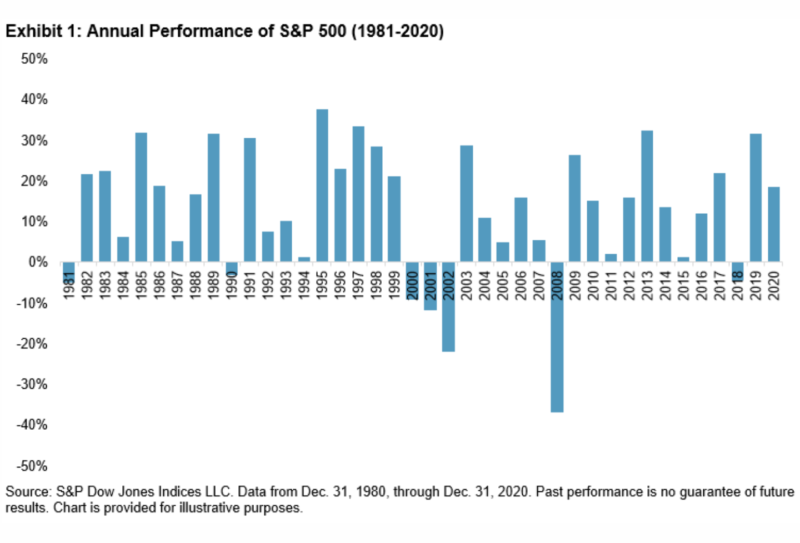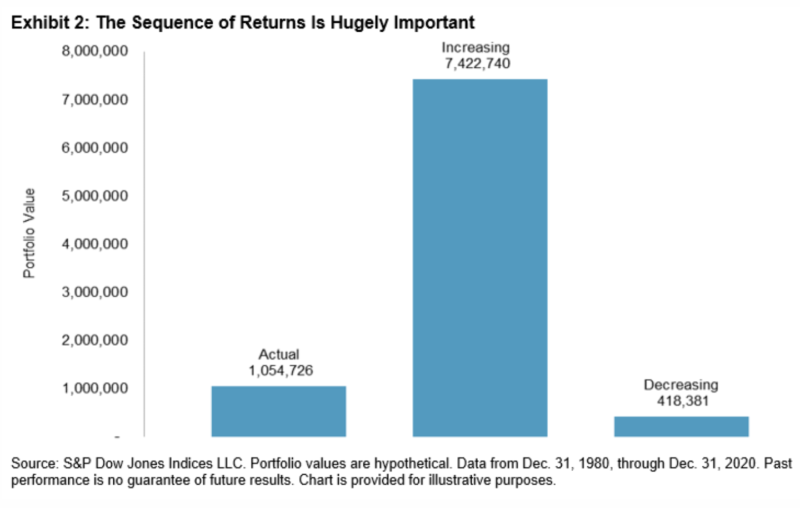
Any proper analysis of an investment strategy must be based on historical market data. But the historical data that we observe were not inevitable; in other words, history might have followed some other course. If it had, the sequence of returns could have looked very different.
Our friends at S&P Dow Jones Indices have been looking at what would have happened to portfolio values if things had worked out differently over the last 40 years, particularly in relation to large-cap US equities.
The findings are very interesting. One consistent finding is that, regardless of the sequence of returns, long-term investors would have been better off using passive funds than active ones. Also, the difference in portfolio values if all of the S&P 500’s worst years had occurred at the start of the period would, as opposed to the end, would have been huge. In other words, the order in which returns occur is extremely important, as S&P’s CRAIG LAZZARA explains.
We all know that stock market returns vary substantially over time. For example, the S&P 500’s performance between 1981 and 2020 ranged from -37% (2008) to +38% (1995). The market’s compound annual return for this period was 11.5%.

Investors, however, live with actual portfolio values, not abstract rates of return. Obviously, and other things equal, portfolio values will rise with larger contributions and with higher returns. But there is an additional, easily overlooked, source of uncertainty. The market generated a particular set of returns, as shown in Exhibit 1, but those returns occurred in a particular order. If the order had been different, the impact on portfolio values would have been profound. Whether we’re interested in extrapolating into the future or simply in understanding alternative historical outcomes, we need to understand both the average level of returns and the order in which they occurred.
We can illustrate this by considering three alternative scenarios, all using the return data from Exhibit 1. We assume that an investor contributes $1,000 at the beginning of 1981, increasing his investment by 5% every year for 40 years, for a total cumulative contribution of $120,800. For each of our three scenarios, we use the actual returns of a hypothetical investment in the S&P 500, but arrange the order differently. The “Actual Order” scenario shows what would have happened if the returns occurred in exactly the order they did. The “Increasing Return Order” scenario assumes that the worst return came first, then the next-to-worst, and so on until the best return occurred in year 40. The “Decreasing Return Order” scenario makes the opposite assumption; the best return would have occurred first, and the worst in year 40.
For all three scenarios in Exhibit 2, the market’s compound growth rate is the same. For all three scenarios, the amount and timing of the investor’s hypothetical contributions are the same. And yet the highest hypothetical portfolio value is nearly 18 times greater than the lowest. Clearly, the order in which returns could have occurred matters a great deal. Actual historical performance lies between the two extremes (and is much closer to the lower than to the upper bound).

Exhibit 2 illustrates an important truth: a portfolio outcome depends in part, but only in part, on the returns the market delivers. Portfolio values also depend importantly on the order or sequence of returns. Modelling portfolios requires us to deal with both sources of uncertainty.
CRAIG LAZZARA is Managing Director and Global Head of Index Investment Strategy at S&P Dow Jones Indices.
This article was first published on the Indexology blog. It draws on the findings of a research paper called Returns, Values, and Outcomes: A Counterfactual History, by Craig Lazzara and Fei Mei Chan. You can download the paper here.
MORE FROM S&PDJI
For more valuable insights from S&P Dow Jones Indices, you might like to read these other recent articles, or visit the Indexology blog:
Why active managers face a tough end to the year
The index effect: how serious is it?
Indexing has saved Americans $357 billion since 1996
Has size contributed to value’s recent revival?
What does history tell us about the value rally?
The case for tracking the venerable Dow Jones
PREVIOUSLY ON TEBI
Invest Your Way to Financial Freedom
Are enhanced index funds genuinely enhanced?
How advisers help to set priorities
Don’t be fooled by the control delusion
Hedge funds: the end of an era?
Picture: Lorenzo via Pexels
© The Evidence-Based Investor MMXXI









